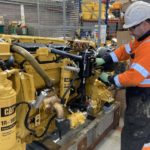Diesel engines play a critical role in keeping industrial equipment running efficiently and productively – from construction apparatus like cranes, screeners, crushers and trommels to agricultural machines such as combine harvesters. But what happens when engines reach the end of their working life?
As machines play such a key role, preventative maintenance is essential in keeping them running as smoothly and efficiently for as long as possible. A machine failure can lead to a multitude of costly issues including unplanned resource downtime. Take the example of an impact crusher, if the engine within the crusher fails, the impact to the site and business operations can be significant. If the engine fails, not only will the site incur unplanned downtime that will need to be recovered, the machines that feed the crusher pre and post operation will also be forced to cease operating, incurring additional downtime and slowing down the whole production line. There are other impacts too, such as a reduction in the overall quantity of the end product which in turn will mean less revenue for the plant.
To ensure the engine runs efficiently for as long as possible, quality maintenance and servicing should be carried out throughout the typical 10,000 to 30,000 working hours a machine will perform. After which, the engine will require a major overhaul or will need to be replaced altogether.
Typically, plant operators will simply buy a newer replacement model, ready to exchange when the existing engine begins to run out of steam. However, this option can be both costly and risky. It can lead to increased operating costs, decreased productivity and unplanned downtime when the machine eventually breaks down, because it is difficult to predict exactly when this will be. In the case of the impact crusher, if the engine breaks down sooner than anticipated the whole plant could be forced into a significant period of downtime whilst a replacement is arranged.
Instead of running equipment until it fails, operators can instead plan in a rebuild of their engines before they reach the end of their lifecycle, giving them a like-new engine at a lower cost than buying new, while avoiding the risks of running an engine near the end of its life. Planning in advance means better efficiencies all round – a scheduled, controlled shut down on site can be managed, alleviating any extended period of unplanned downtime. Scheduling a rebuild also gives the operator time to lease a rental replacement, ensuring business runs as normal.
As good as new
Many industrial engines are built in a similar way, with minor component variations. This means that in reality the difference between an engine on a drill rig, a crusher or a crane are usually relatively small – therefore the repair strategy is often determined by budget and power restoration requirements, rather than by application.
Where a like-new engine is required, operators can select a complete overhaul. During a full workshop recondition, all major components are stripped out and replaced. This includes the seals, gaskets, bearings and filters. Approximately three quarters of engine parts can be recycled, and, with this more thorough option, operators can swap out these components so that they can be restored and reinstalled on another engine.
A sustainable choice
There are options to suit different budgets and requirements where a like-new replacement is either not needed or viable. If the engine is experiencing a loss of power or excessive fuel consumption, operators can choose a mid-range top and tail recondition. This approach involves renewing all major components, including the cylinder pecks and heads, the injectors and pistons. All slower-wearing parts, such as piston pack groups, lube oil and water pumps, are also replaced. If the engine is halfway through its 30,000-hour lifecycle, this option will restore vital power and can provide an additional 15,000 hours of runtime.
Where less work is required, a basic value repair will recondition the cylinder heads, piston rings and liners. This option is ideal if a tractor or crusher, for example, is experiencing a slightly increased fuel consumption and a short-term solution is needed that will see the engine through to its next service.
Get the support you need
When rebuilding an industrial engine, it’s essential operators receive lifecycle assistance, which means having a partner that can offer good technical and commercial support. The rebuild process does not end the minute that the engine leaves the workshop — a good partner will reinstall the engine on the operator’s site and regularly service it to ensure that it is running as intended.
By selecting a partner early on, the operator can understand where the engine is in its lifecycle and collaborate with the service provider’s engineers to devise a tailored support strategy. Look for a partner that uses genuine OEM parts on all its engine rebuilds, supports its customers with preventative maintenance using scheduled fluid analyses and offers machine telematics to regularly monitor engine condition and performance.
Industrial machines experience significant wear and tear in their daily lives helping to keep sites running. For operators that rely on uptime, an engine rebuild can give their machines a new lease of life by restoring performance.
Those who partner with Finning benefit from Cat®certified engineers who carry out a thorough inspection and evaluation of their industrial engine and can replace up to 7,000 of its components with genuine Cat parts. We have engineers working across the UK and Ireland, meaning we can react promptly to your needs. Want to know more about our industrial engine rebuilds? Visit the Finning website.









